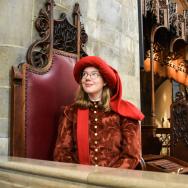Bram Stoker’s Dracula, the iconic 1897 tale of a vampire from Transylvania, is often thought to be inspired by a formidable 15th-century governor from present-day Romania named Vlad the Impaler.
To examine the historical roots of the legendary character, undergraduates in a unique College course entered the worlds of superstition and supernatural by reading newly translated letters written by Vlad himself. Throughout the course, students were given a unique look at his motivations, helping to transform their understanding of a figure often seen as bloodthirsty.
“I thought Vlad was going to be this kind of genius—the way that he was able to murder so many people—and I asked myself: ‘How did he not upset the masses sooner?’ But then I realized, he really didn’t have too many plans,” said second-year student Marcus Jaramillo. “The media represents him as elegant, but the history is saying that he is brutal and savage, and kind of scared and paranoid.”
Designed to introduce students to historical methods and reasoning, “Dracula: History & Legend” begins with an in-depth study of Vlad III Dracula and his motivations as he tried to govern the region of Wallachia on the Hungarian-Ottoman/Christian-Muslim frontier. Later, students study early folklore before reading Dracula and watching film adaptations. For the final projects, students create a documentary showcasing their thoughts on the “real” Dracula or Vlad the Impaler.
And on Halloween, many of the students dressed the part of the legendary character, although they appeared a little grim as they listened to the folklore around the ways to kill a vampire.
“It’s Dracula and Vlad the Impaler,” said second-year student André Altherr. “It’s a course that you don’t anticipate appearing many times. You want to seize your chance and take it.”
The course is taught by Assoc. Prof. Jonathan Lyon, a medieval historian interested in the ways in which the Western European perspective gets projected onto Eastern Europe. According to Lyon, the course is unusual because it uses a novel not only as a literary text, but as a historical source. Until a few years ago, there were few accessible English texts about Vlad the Impaler and little Eastern European scholarship of this time period more broadly.
“The hope is that when we read Bram Stoker’s Dracula together, it’s still a great novel and horror story. But I also want them to read between the lines and realize that there is so much more that Bram Stoker is bringing to the table in terms of European attitudes about Romania, civilization and whether this Dracula guy belongs to European civilization,” Lyon said.
“It really is this sort of civilizational narrative about a wicked person from the past who brings centuries of Eastern European backwardness when he comes to London.”
The class is also based upon Lyon’s travels around Eastern and Western Europe. He occasionally teaches abroad in Vienna, covering the early modern section of European history. Lyon also has lived in Vienna and Germany and conducts research in areas including the Balkans, Hungary and Romania.
“In the United States, there are not that many medieval historians who study Germany and especially not central Europe,” Lyon said. “I take seriously that there aren’t that many people who think about the history of central Europe before the 1500s. So I’m always thinking about ways in which I can impart that knowledge.”
—Adapted from a story by Devon Wenzel that first appeared on the College website.

